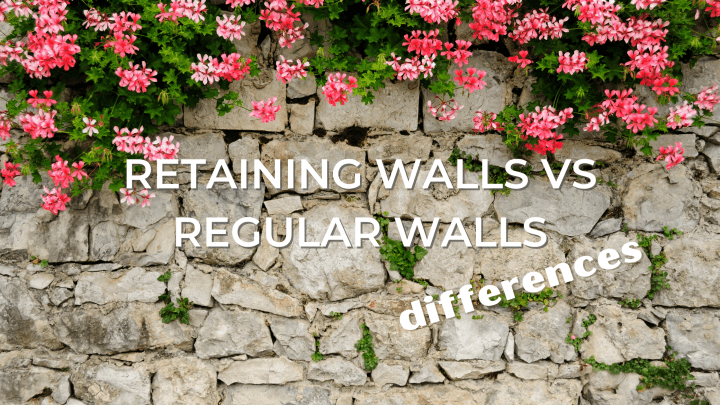Retaining walls and normal walls both serve similar purposes: they’re both built to protect or hold something in place. However, a few notable differences set them apart from one another.
The biggest difference between retaining walls and normal walls is their construction style and use. Normal walls, like those in your home, utilize treated wood and add to the structure of your home. Retaining walls are made of brick or stone and create an outdoor barrier for landscaping and drainage.
This article will go into detail about the biggest difference between retaining walls and normal walls and the differences in construction style and use.
What Is the Purpose of a Retaining Wall?
Retaining walls are built to utilize the soil around them in their construction. While most normal walls start this way, they usually include bricks, stones, and other hard materials for added strength.
A retaining wall is a structure built to hold something in place, usually soil, but it can also be used as a barrier against water and erosion. Retaining walls are also used to make a slope in your landscape functional and provide improved drainage.
These types of walls are specially designed to hold tremendous amounts of weight (as we detail here) without breaking away because their design forces them to push back against natural gravity that would otherwise try to pull down on them.
These structures could easily collapse (for many reasons) if not built properly because if rocks/bricks were stacked on top of one another, gravity would force them to collapse under their own weight. Thus, they utilize masonry adhesive or interlocking features to strengthen.
Retaining Walls Are Used for Aesthetics and Drainage
Retaining walls are built to prevent land erosion, mostly because it’s more cost-effective than other methods of preventing land erosion.
Some retaining walls also give architects and landscape designers the opportunity to be creative with their designs by creating something aesthetically pleasing for passersby, including viewing terraces (like in modern-day hospitals or luxury apartments) or gardens (like most people use in their yard).
Retaining walls can also be used to make an inclined plane for purposes like creating better drainage during rainstorms, which prevents standing water on streets that could potentially cause flooding/slipping hazards if not handled properly.
The Durability of Retaining Walls vs. Normal Walls
One way that retaining walls are different from normal walls is in their durability. Some types of retaining walls can last upwards of a hundred years without needing replacement. This is while being exposed to the elements in nature!
Normal walls can be equally durable, like the walls sitting on top of your home’s foundation, but in general, most walls are made from wood and drywall and can’t withstand the same amount of wear and tear as a solid concrete wall.
While you won’t be replacing your interior walls often, they’re also not exposed to as much abuse as their retaining wall cousins.
How Does Retaining Wall Construction Differ From Normal Wall Construction?
Retaining wall material is typically at least five times stronger than normal wall material to handle the massive amounts of force when soil presses up against it. The support beams used on these types of structures are thicker because more weight is involved.
Retaining walls and normal walls use different materials, tools, and techniques. Retaining walls are much sturdier than normal walls and are made with much stronger materials like poured concrete.
The tools that are typically used for retaining walls are:
- Shovels – for digging holes
- Posthole diggers – for creating square holes with vertical sides
- Tampers – for compacting dirt efficiently before using it for building material
- Lutes – for applying adhesives to walls before adding more building material
Normal walls, often made of wood and drywall, are assembled with those materials, utilizing fasteners to keep them together.
The Differences in Construction Between Retaining Walls and Normal Walls
There are many differences between how a retaining wall is constructed and how normal walls are built.
Retaining Wall
To build a retaining wall, the first step is to dig a trench. This can be done by using either a shovel or post hole digger, depending on how deep it has to go.
If retaining walls are made of stone or brick, they’re stacked and held together with a masonry adhesive and either metal reinforcement bars (i.e., rebar) or a cement mesh.
Retaining walls can also be made of wood, concrete, or even railroad ties. These are assembled by either stacking materials with adhesive or fasteners to strengthen them or by pouring concrete.
Because of the added material cost and the engineering complexity, retaining walls often cost more. However, there are cheaper ways to build them (as we documented fully here).
Normal Wall
Normal wall construction is entirely different from retaining wall construction because it assembles several materials together like wood beams and drywall. Normal walls often use nails or screws, depending on what material they’re made out of. A normal wall will require tools such as:
- Hammers
- Nails/screws
- Drills
- Levels, etc.
For foundation walls, concrete is poured similarly but used to hold up a vertical structure rather than just holding soil in place. The design of both varies by how much weight each one can handle.
Wood retaining walls often use some of the materials, but brick or masonry retaining walls rely on adhesives to strengthen the wall. They’re built vertically using a stacking method to offset the horizontal pressure from the landscape behind them.
Conclusion
A retaining wall is built with specific characteristics that pertain to what materials are used to construct it. They’re usually made of wood, concrete blocks, brick, stacked stone, or poured concrete. The critical difference in comparing normal walls and retaining walls is their construction style and purpose.

